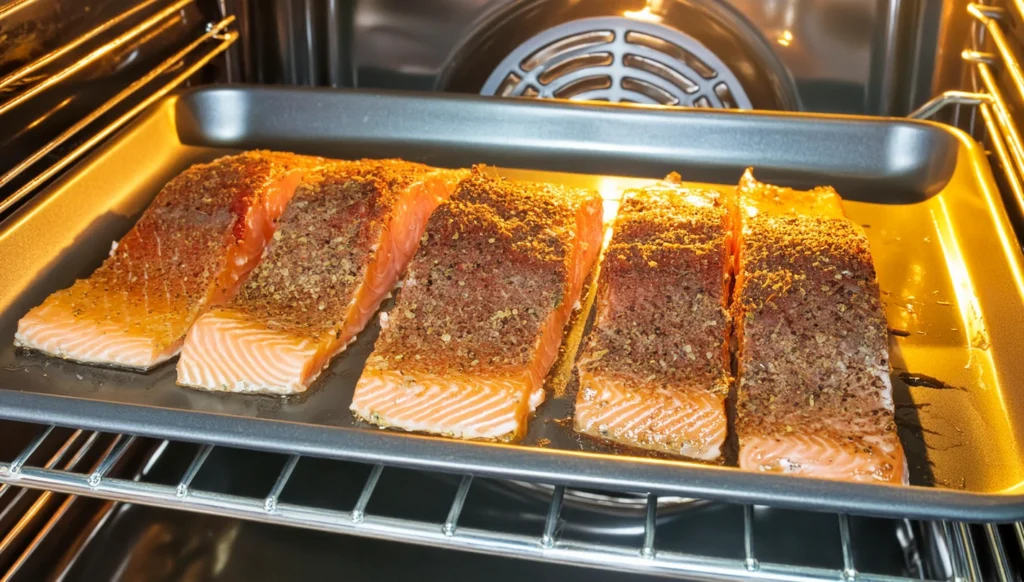
Introduction to Coho Salmon
Coho salmon, often referred to as silver salmon, is prized for its delicate flavor and firm texture. Native to the Pacific Northwest and available from Alaska to central California, this species thrives in the cold, clean waters of the Pacific Ocean. As a sought-after choice for many seafood enthusiasts, coho salmon is not only delicious but also packed with nutritional benefits, making it a superb addition to a healthy diet.
Understanding the unique qualities of Coho salmon is essential for cooking it perfectly. Unlike its fattier cousins like sockeye or king salmon, coho has a lower fat content, which can pose a challenge for those trying to cook it without drying it out. Here are some key points to consider:
- Nutritional Profile: Coho salmon is a powerhouse of nutrients. It is rich in omega-3 fatty acids, which are crucial for cardiovascular health and cognitive functions. Additionally, it provides a good amount of protein and essential vitamins like D and B12, important for overall health and energy levels.
- Culinary Versatility: This salmon is versatile in the kitchen, suitable for a variety of cooking methods such as grilling, broiling, and pan-searing. Its mild flavor makes it a perfect canvas for a range of seasonings and marinades.
Preparing Coho Salmon
Before you begin cooking, selecting the right quality of salmon is critical. Here’s how to make sure you get the best:
- Fresh vs. Frozen: Coho salmon is available both fresh and frozen. While fresh may offer a slight edge in texture, frozen coho is often flash-frozen at peak freshness, preserving its quality and nutritional value.
- Signs of Quality: Look for salmon with moist, shiny skin and firm flesh. If buying frozen, ensure the package is free of frost or ice crystals, which can indicate that it has been stored for too long or thawed and refrozen.
Proper handling and storage are as important as the cooking process itself:
- Refrigeration: Keep salmon refrigerated until ready to cook. If not used within a day of purchase, ensure it’s wrapped properly and stored in the coldest part of your fridge.
- Thawing Techniques: Thaw frozen salmon in the refrigerator overnight, not at room temperature. For quicker thawing, submerge the sealed package in cold water, changing the water every 30 minutes to ensure it remains cold.
Ensuring your coho salmon is prepared properly will set the stage for a delicious meal that retains all its moisture and flavor. Now, let’s explore the various cooking methods to keep your coho salmon succulent and flavorful.
For additional recipes and cooking tips Coho Salmon, consider exploring our Delicious Coho Salmon Recipe for creative ways to utilize different parts of the salmon.
Cooking Techniques
Cooking coho salmon so it retains its moisture and flavor involves using the right techniques. Here are the best methods to ensure your salmon is perfectly cooked every time:
How do you cook coho salmon so it’s not dry?
- Overview of Cooking Techniques:
- To avoid drying out the delicate flesh of coho salmon, it’s crucial to understand which methods best preserve its moisture. These include poaching, pan-searing, and broiling—each providing a way to enhance the salmon’s natural flavors while keeping it tender and juicy.
Poaching Coho Salmon

Poaching is a gentle way to cook coho salmon that ensures it doesn’t dry out:
- Benefits of Poaching:
- This method cooks salmon evenly in a liquid at a low temperature, which helps retain its moisture and tenderness.
- Step-by-Step Poaching Guide:
- Ingredients:
- Water or a flavorful broth
- Fresh herbs (like dill or parsley)
- Slices of lemon
- Salt and pepper
- Instructions:
- Fill a shallow pan with enough water or broth to cover the salmon fillets.
- Add herbs, lemon slices, and seasoning to the liquid and bring to a gentle simmer.
- Place the salmon fillets in the pan, skin-side down.
- Cover and cook at a low simmer for about 10-15 minutes or until the salmon is just cooked through.
- Remove from the liquid and serve immediately.
- Ingredients:
Pan-Searing Coho Salmon
Pan-searing gives coho salmon a crisp exterior while keeping the inside moist:
- Equipment Needed: A non-stick skillet or cast iron pan.
- Instructions for a Perfect Pan-Sear:
- Ingredients:
- Coho salmon fillets
- Salt and pepper
- Olive oil or butter
- Instructions:
- Pat the salmon dry and season with salt and pepper.
- Heat the oil or butter in a pan over medium-high heat.
- Place the salmon skin-side down in the pan.
- Cook for 3-4 minutes until the skin is crisp.
- Flip the salmon and cook for an additional 3-4 minutes or until desired doneness.
- Serve immediately with a wedge of lemon.
- Ingredients:

Broiling Coho Salmon
Broiling is a quick method that can add a delicious char to your salmon:
- Advantages of Broiling:
- Broiling exposes the salmon to direct heat, creating a slightly crispy exterior while locking in moisture.
- Detailed Broiling Process:
- Ingredients:
- Coho salmon fillets
- Olive oil
- Salt and pepper
- Instructions:
- Preheat the broiler and prepare a broiler pan by lightly oiling it.
- Brush the salmon with olive oil and season with salt and pepper.
- Place the salmon skin-side down on the prepared pan.
- Broil about 4-6 inches from the heat source for 5-7 minutes, checking frequently to prevent overcooking.
- The salmon is done when it flakes easily with a fork.
- Ingredients:
Using these techniques, you can enjoy moist and flavorful coho salmon every time you cook. Next, we’ll explore recipes and flavor pairings that enhance the natural taste of coho salmon.
For more culinary inspiration, check out our guide on how to make the most of the salmon’s belly for delicious and inventive dishes.
Recipes and Flavor Pairings
Experimenting with recipes and flavor pairings can significantly enhance the delicate taste of coho salmon. Here are some simple recipes and suggestions for ingredients that complement this type of salmon well.
Simple Coho Salmon Recipes
These recipes emphasize minimal ingredients and straightforward preparation to highlight the natural flavors of coho salmon:
- Recipe for Poached, Pan-Seared, and Broiled Salmon:
- Poached Salmon:
- Ingredients:
- 1 coho salmon fillet
- 4 cups water or fish stock
- 1 lemon, sliced
- A handful of fresh dill
- Salt and pepper to taste
- Instructions:
- Combine water or stock, lemon slices, dill, salt, and pepper in a large skillet and bring to a simmer.
- Add the salmon, cover, and gently poach for 10-15 minutes or until cooked through.
- Serve with steamed vegetables or a light salad.
- Ingredients:
- Pan-Seared Salmon:
- Ingredients:
- 1 coho salmon fillet
- 2 tbsp olive oil
- Salt and freshly ground black pepper
- Instructions:
- Heat olive oil in a non-stick skillet over medium-high heat.
- Season the salmon with salt and pepper and place it skin-side down in the skillet.
- Cook for 3-4 minutes on each side until golden and crisp.
- Serve with a drizzle of lemon juice and a side of mashed potatoes.
- Ingredients:
- Broiled Salmon:
- Ingredients:
- 1 coho salmon fillet
- 2 tbsp olive oil
- Salt and pepper
- A sprinkle of red chili flakes (optional)
- Instructions:
- Preheat the broiler.
- Brush the salmon with olive oil and season with salt, pepper, and chili flakes.
- Broil 4-6 inches from the heat source for 5-7 minutes, or until the top is slightly charred and the fish is cooked through.
- Serve with a side of rice and grilled asparagus.
- Ingredients:
- Poached Salmon:
Flavor Pairings
The mild flavor of coho salmon pairs well with a variety of ingredients. Here are some recommended combinations:
- Herbs and Spices: Dill, parsley, basil, and tarragon enhance the fish’s natural flavors without overpowering it.
- Sauces and Garnishes: Mustard dill sauce, soy ginger glaze, and lemon butter sauce are excellent for adding depth to the mild taste of coho.
- Wine Pairings: A light Pinot Grigio or Chardonnay complements the delicate texture and flavor of coho salmon, making it a perfect match for a sophisticated dinner.
FAQs
Addressing common questions can help ensure success in the kitchen when preparing coho salmon:
- How long should I cook coho salmon?
- Cooking time varies depending on the method but generally ranges from 10 to 15 minutes. It’s crucial to check the salmon frequently to prevent overcooking.
- What is the best way to ensure coho salmon doesn’t dry out?
- Using low-heat cooking methods like poaching or quick, high-heat methods like broiling can help preserve moisture. Always watch the cooking time closely.
- Can coho salmon be cooked from frozen?
- Yes, coho salmon can be cooked from frozen by extending the cooking time by approximately 50%. However, for best texture and flavor, thawing in the refrigerator overnight is recommended.
Additional Tips and Tricks
To round out your coho salmon cooking guide, here are some additional tips to ensure every dish turns out perfectly:
- Common Mistakes When Cooking Salmon:
- Overcooking is the most common mistake. Keep an eye on the fish as it cooks and use a fork to test for doneness.
- Tips for Achieving Perfect Doneness:
- Remove salmon from the heat just before it’s done, as it will continue to cook from residual heat.
- How to Use Leftovers Effectively:
- Flake leftover salmon over salads, mix into pasta, or incorporate into omelets for a nutritious meal.
With these techniques, recipes, and tips, you’re well-equipped to cook coho salmon that is moist, flavorful, and perfectly prepared. Enjoy the process and the delicious results!
